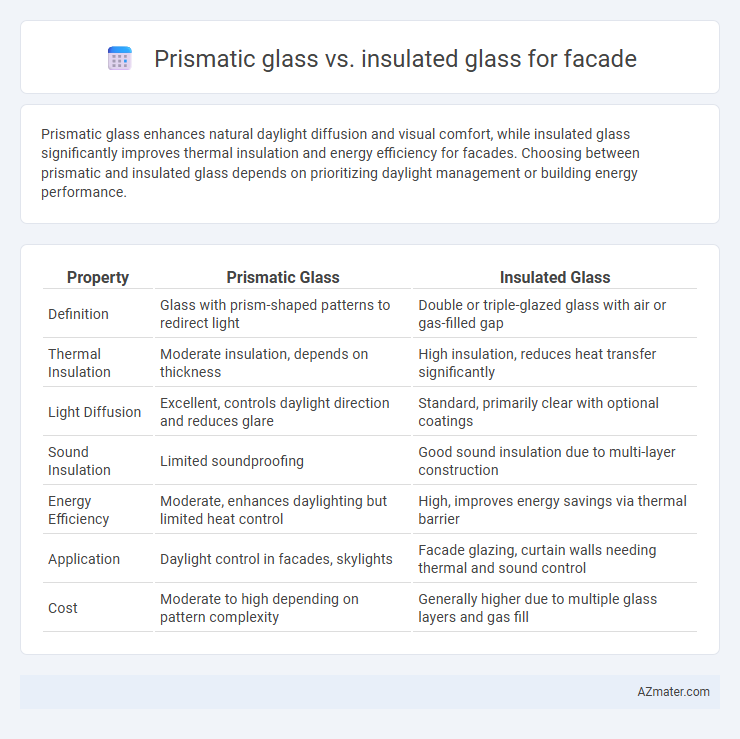Prismatic glass enhances natural daylight diffusion and visual comfort, while insulated glass significantly improves thermal insulation and energy efficiency for facades. Choosing between prismatic and insulated glass depends on prioritizing daylight management or building energy performance.
Table of Comparison
| Property | Prismatic Glass | Insulated Glass |
|---|---|---|
| Definition | Glass with prism-shaped patterns to redirect light | Double or triple-glazed glass with air or gas-filled gap |
| Thermal Insulation | Moderate insulation, depends on thickness | High insulation, reduces heat transfer significantly |
| Light Diffusion | Excellent, controls daylight direction and reduces glare | Standard, primarily clear with optional coatings |
| Sound Insulation | Limited soundproofing | Good sound insulation due to multi-layer construction |
| Energy Efficiency | Moderate, enhances daylighting but limited heat control | High, improves energy savings via thermal barrier |
| Application | Daylight control in facades, skylights | Facade glazing, curtain walls needing thermal and sound control |
| Cost | Moderate to high depending on pattern complexity | Generally higher due to multiple glass layers and gas fill |
Introduction: Prismatic Glass vs Insulated Glass Facades
Prismatic glass facades enhance natural daylight by redirecting sunlight deeper into interiors, improving energy efficiency and visual comfort. Insulated glass facades consist of multiple glass panes separated by air or gas-filled spaces, providing superior thermal insulation and noise reduction. Choosing between prismatic and insulated glass facades depends on balancing daylight optimization with thermal performance for building envelope efficiency.
Understanding Prismatic Glass: Key Features
Prismatic glass enhances facade performance by incorporating micro-structured surfaces that refract and diffuse daylight, improving natural light distribution while reducing glare. This energy-efficient glazing option optimizes solar control without compromising transparency, making it ideal for sustainable building designs. Compared to insulated glass, prismatic glass prioritizes light management and visual comfort over thermal insulation.
Insulated Glass Explained: Structure and Benefits
Insulated glass for facades consists of two or more glass panes separated by a spacer filled with air or inert gas, significantly enhancing thermal insulation and reducing energy consumption in buildings. This multi-layered structure minimizes heat transfer and condensation, improving indoor comfort while decreasing HVAC system loads. Its superior soundproofing and increased durability also make insulated glass a preferred choice over prismatic glass for modern architectural facades.
Energy Efficiency Comparison
Prismatic glass enhances natural daylight penetration while reducing glare, contributing to lower artificial lighting needs and moderate solar heat gain control in facades. Insulated glass, composed of multiple panes with air or gas-filled spaces, offers superior thermal insulation, minimizing heat transfer and significantly improving energy efficiency by reducing heating and cooling demands. When comparing energy performance, insulated glass outperforms prismatic glass by delivering better overall thermal resistance and airtightness, making it the preferred choice for energy-efficient building envelopes.
Daylighting and Visual Comfort
Prismatic glass enhances daylighting by redirecting sunlight deeper into interior spaces, reducing glare and creating uniform illumination for improved visual comfort. Insulated glass primarily focuses on thermal performance but can include low-E coatings to control solar heat gain and diffuse light, contributing to balanced daylight without excessive brightness. Combining prismatic elements with insulated glazing optimizes facade performance by maximizing natural light penetration while maintaining thermal efficiency and visual comfort.
Thermal Performance and Insulation
Prismatic glass enhances natural light distribution and reduces solar heat gain, improving thermal performance by minimizing reliance on artificial cooling. Insulated glass units (IGUs) consist of multiple glass panes separated by a spacer filled with air or gas, significantly increasing thermal insulation and reducing heat transfer. Combining prismatic glass with insulated glazing can optimize facade energy efficiency by balancing daylight control and superior insulation.
Aesthetic and Design Possibilities
Prismatic glass offers dynamic light diffusion and striking visual effects, enhancing facade aesthetics with vibrant color shifts and textured patterns that create unique architectural statements. Insulated glass provides sleek, modern transparency with superior thermal performance, allowing expansive glass surfaces without sacrificing energy efficiency or comfort. Combining prismatic elements with insulated glass components unlocks versatile design possibilities, balancing artistic expression with functional sustainability in contemporary building facades.
Durability and Maintenance Requirements
Prismatic glass offers enhanced durability due to its inherent resistance to scratches and environmental wear, making it ideal for facades exposed to harsh weather conditions. Insulated glass, featuring multiple panes separated by a spacer and sealed with inert gas, provides superior thermal insulation but requires regular maintenance to ensure the integrity of seals and prevent condensation. Both types demand specific upkeep; prismatic glass benefits from straightforward cleaning routines, while insulated glass necessitates periodic inspections to maintain its energy efficiency and prevent seal failure.
Cost Considerations for Building Projects
Prismatic glass typically incurs higher upfront costs due to its specialized light-diffusing design, which enhances natural daylighting but requires advanced manufacturing processes. Insulated glass units (IGUs) offer better thermal performance and energy efficiency, often translating to long-term cost savings despite moderate initial expenses. Choosing between prismatic and insulated glass for facades involves balancing initial budget constraints against future energy savings and maintenance costs.
Which Glass Type is Best for Your Facade?
Prismatic glass enhances facade aesthetics and daylighting by redirecting natural light deeper into interiors, reducing glare and energy consumption, making it ideal for projects focused on visual comfort and sustainable illumination. Insulated glass units (IGUs) provide superior thermal insulation with dual or triple panes and gas fills, significantly improving energy efficiency and noise reduction, suited for climates with extreme temperature variations. For facades requiring a balance between daylight management and thermal performance, combining prismatic coatings with insulated glass technology offers an optimal solution tailored to energy codes and occupant comfort.

Infographic: Prismatic glass vs Insulated glass for Facade
 azmater.com
azmater.com